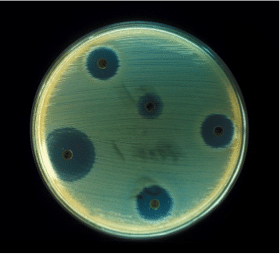In almost every research lab, antibiotics are frequently used, whether it is in cell culture or molecular biology techniques. Do you know how to properly dispose of antibiotic waste (e.g., unused media, autoclaved media, old antibiotic stocks)? Have you ever considered if you are disposing of them appropriately? Read on to know what proper antibiotic disposal in the lab looks like and why it is essential.
Why is it Important to Get Antibiotic Disposal in the Lab Right?
Although antibiotics are a boon to the global health system, careless disposal can quickly turn them into a bane.
When flushed down sinks or toilets, antibiotics reach wastewater treatment plants, where bacteria after constant exposure to these antibiotics form superbugs — multi-resistant bacteria. Acinetobacter is an example of one such superbug. [1]
Studies report that improper disposal of medical/research waste — from hospital, laboratory and pharmaceutical industries — results in antibiotics and other drugs in drinking water, causing a negative impact on human health and the environment. [2]
To prevent these adverse effects, every institution has a set of rules for the safe disposal of laboratory waste. Before diving further into the topic, it is essential to look at used media as biohazard and antibiotics as chemical waste —which means anything with antibiotics should be considered as chemical waste (unless your institution mentions otherwise)!
Dealing with Antibiotics in Used Media
Autoclaving used cell culture media destroys pathogens but not some types of antibiotics. It was surprising to know how some antibiotics are heat stable while others are not. If an antibiotic you are using doesn’t fall under the below two categories, please contact your institutional EHS (Environment & Health Services) for guidance.
The antibiotics in Table 1 are destroyed during an autoclave cycle and, as an exception, could be safe to drain down the sink after autoclaving, but only if other harmful chemicals are absent. However, always ensure to follow the advice of your institution.
Conversely, antibiotics in Table 2 are not destroyed by autoclave; autoclaved media with these antibiotics is a chemical waste and should be disposed of as per your institutional guidelines. In addition, used labware should be properly decontaminated before being correctly disposed of (e.g., in sharps box). [3]
Table 1. List of Heat-Sensitive Antibiotics
Ampicillin | Kanamycin |
Amphotericin | Neomycin |
Carbenicillin | Puromycin |
Penicillin | Streptomycin |
Geneticin | Tetracycline |
Table 2. List of Heat-Stable Antibiotics
Hygromycin B |
Chloramphenicol |
Ciprofloxacin |
Vancomycin |
Nalidixic acid |
Gentamicin |
Table 3 gives some additional information on how different antibiotics can be deactivated [4]
Antibiotics | Recommendation |
Beta-lactams | |
Ampicillin | Autoclaved/boiled |
Carbenicillin | |
Penicillin | |
Aminoglycosides | |
Geneticin (G418) | Autoclaved/boiled |
Gentamycin | |
Neomycin | |
Streptomycin | |
Kanamycin | Not destroyed by normal autoclaving/boiling. Can be autoclaved at very acidic pH. Alternatively, it must be delivered as chemical waste |
Others | |
Chloramphenicol | Presented as high-risk waste (NOT destroyed by autoclaving/boiling) |
Amphotericin = Fungizon | Autoclaved/boiled |
Erythromycin | |
Puromycin | |
Sulfadoxin | |
Tetracycline | |
Blasticidin | Presented as high-risk waste (unknown properties) |
Ciprofloxacin | Presented as high-risk waste (NOT destroyed by autoclaving) |
Enrofloxacin | Presented as high-risk waste (unknown properties) |
Nalidixic acid | Presented as high-risk waste |
Vancomycin | Presented as high-risk waste and must be removed completely! (Very stable, last antibiotics that work against multi-resistant staphylococci) |
Zeomycin | Presented as high-risk waste (unknown properties) |
Zeocin | |
Antibiotics in Unused Media?
Although unused media is devoid of pathogens, it still needs to be treated appropriately (as per Table 3) for any antibiotics present and disposed of safely as per your institutional guidelines. [3]
Autoclave and chemical decontamination can only be used to deactivate antibiotics in culture media; these methods should not be used to discard stock antibiotic solutions.
So, What About Stock Antibiotics Solutions?
Stock antibiotics solutions are usually at much higher concentrations than those used in media and are considered hazardous chemical waste. They should be collected in an approved container for chemical waste and disposed of following institutional guidelines.
Summary of Antibiotic Disposal in the Lab
In conclusion, not all antibiotics have the same methods of disposal. Some are heat sensitive, while others are not. When just autoclaving is not enough, media with antibiotics should be considered as chemical waste and disposed of correctly.
Although this article provides basic information on the proper disposal of antibiotics, it is imperative to consult and follow institutional guidelines to ensure the correct disposal of your laboratory waste – as rules may differ by location. Finally, it is crucial to have careful and responsible practice for safe disposal of antibiotic waste, to prevent any damage to our health and environment.
How do you dispose of your antibiotics? Does your institution have specific guidelines other than those mentioned here? Share your insights in the comments below to help other researchers!
References
- Zhang Y et al. Wastewater treatment contributes to selective increase of antibiotic resistance among Acinetobacter spp. Science of The Total Environment 2009; 407(12):3702–3706. doi:10.1016/j.scitotenv.2009.02.013.
- Zuccato E et al. Presence of therapeutic drugs in the environment. Lancet, 2000; 355(9217):1789–1790. doi:10.1016/S0140-6736(00)02270-4.
- National Institute of Health. Office of Management. Waste Management Services. Accessed August 20, 2020.
- Meyer EL et al. Is Your Institution Disposing of Culture Media Containing Antibiotics? Applied Biosafety 2017; 22(4):164–167. doi:10.1177/1535676017735521.







